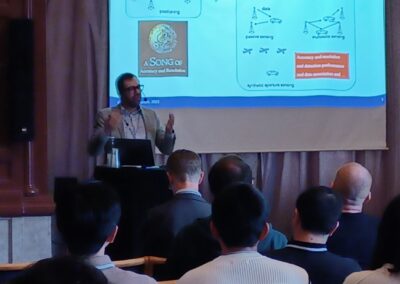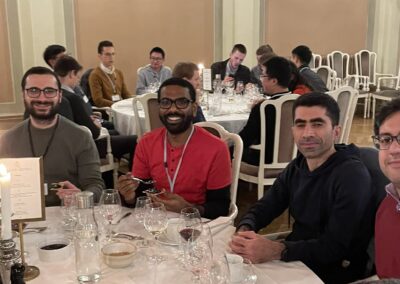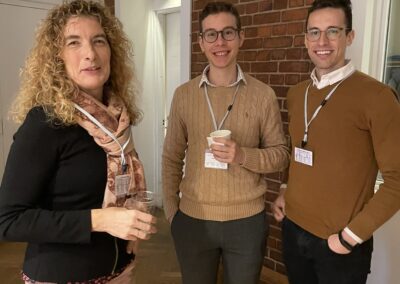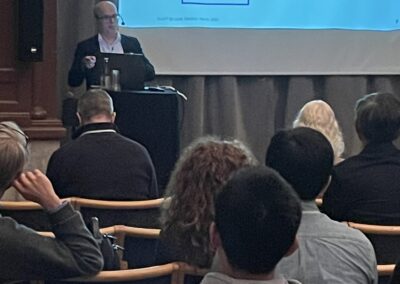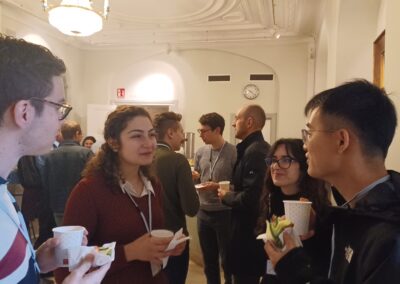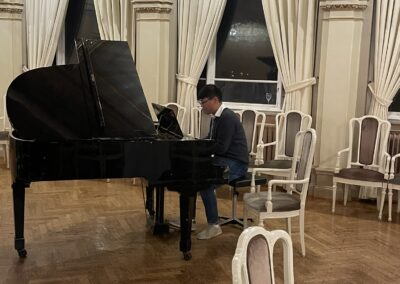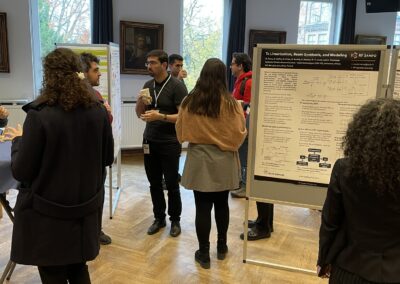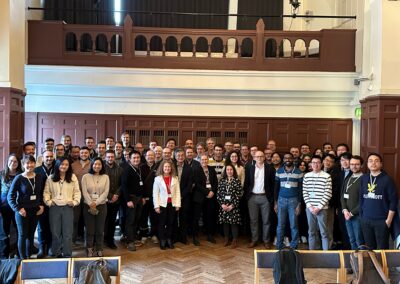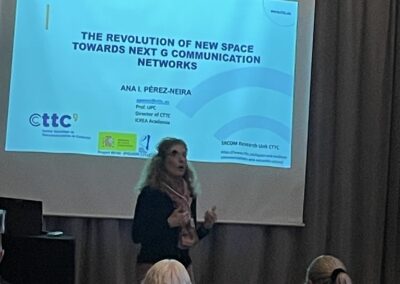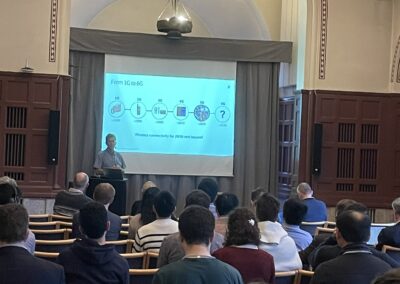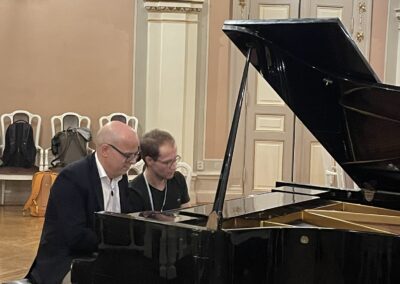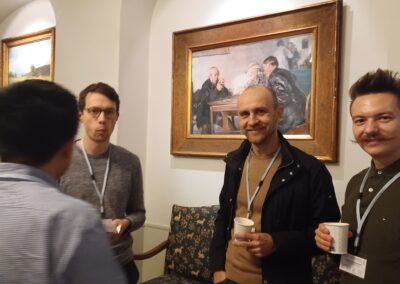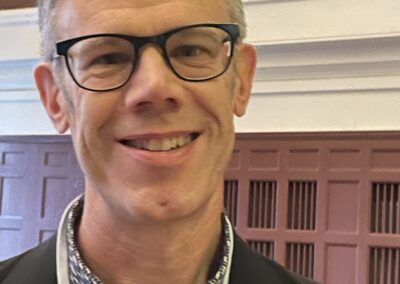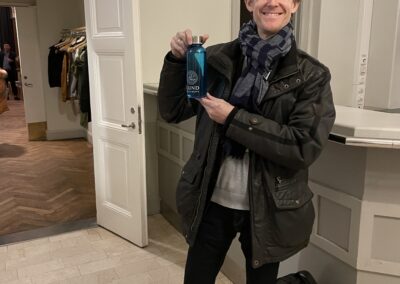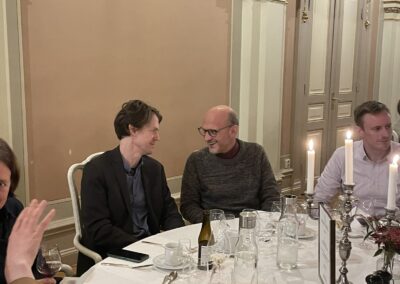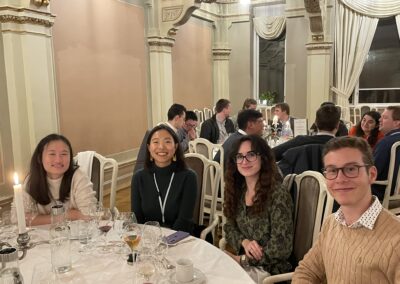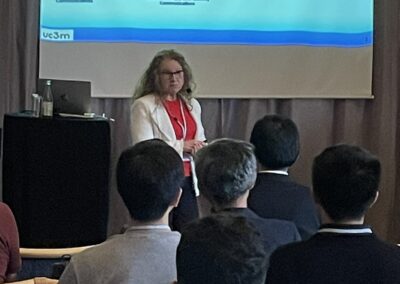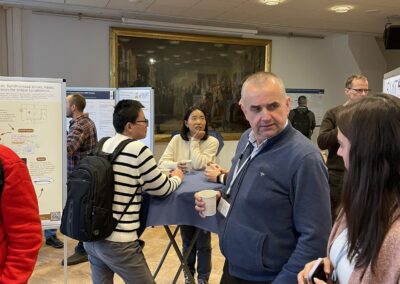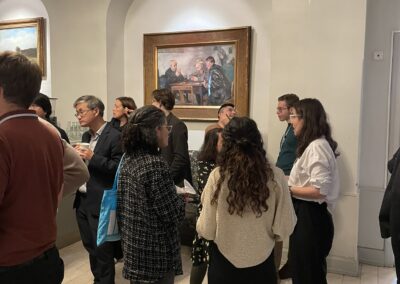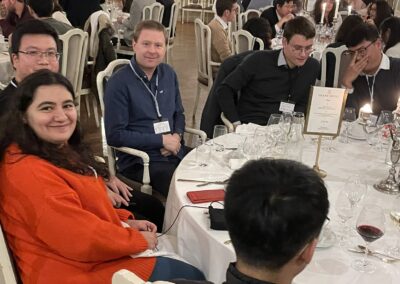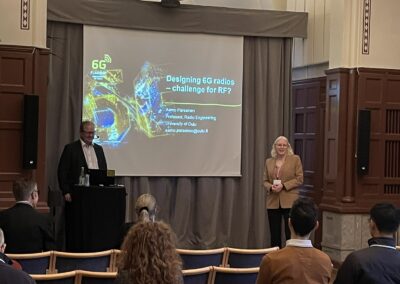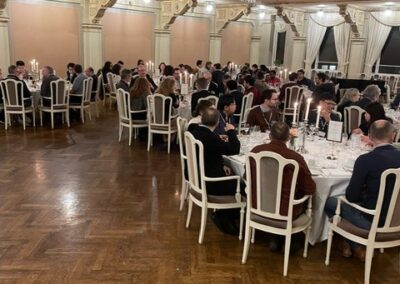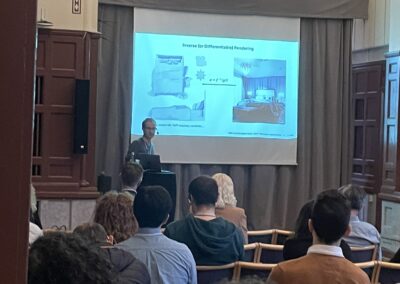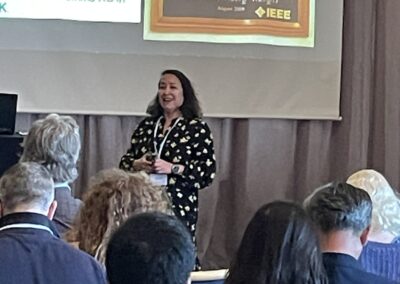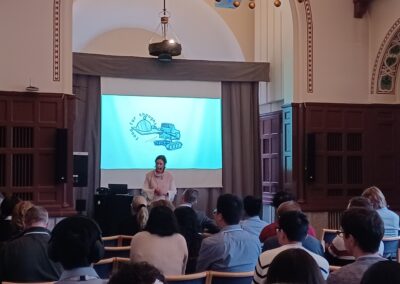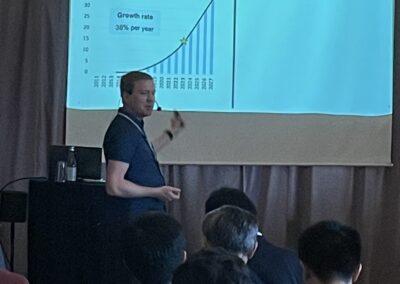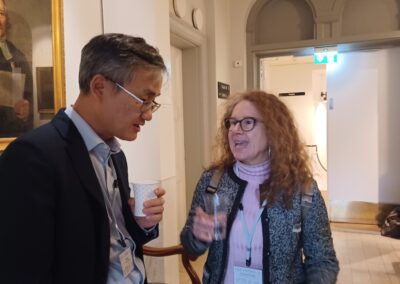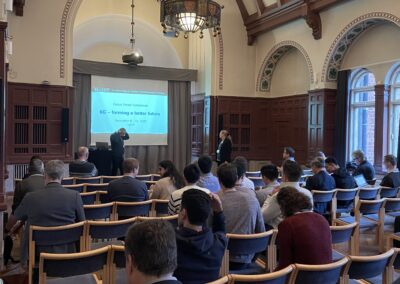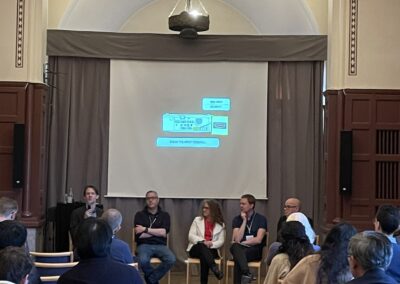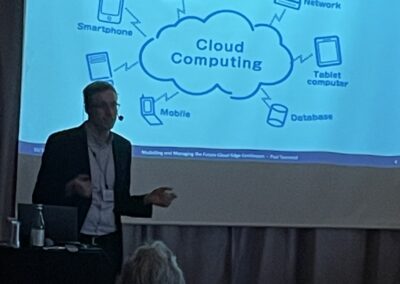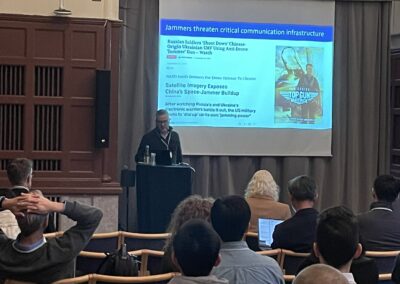Detailed program
Welcome Reception – November 7, 2023
17:00 - 19:00
Kulturen i Lund
Tegnérsplatsen 6, 223 50 Lund
Welcome reception
A welcome drink and some hors d’oeuvres will be served.
Day 1 – November 8, 2023
08:30 - 09:00
Akademiska Föreningen
Sandgatan 2, Lund
Registration
09:00 - 09:15
Introduction
09:15 - 10:00
6G – Connecting a cyber-physical world
Stefan Parkvall, Senior Expert at Ericsson Research, Sweden
Abstract
In 2030, society will have been shaped by 5G for about 10 years. Even with the built-in flexibility of 5G, we are beginning to see the horizon where further capabilities are needed to meet the needs of the future. 6G is still at the research stage, with potential technologies and features being discussed in industry and the research community. However, work in 3GPP is not that far into the future. Currently, 3GPP is finalizing release 18 and will start working on release 19 in 2024. It is expected that 6G requirements will be discussed during 2024, followed by technical studies and standardization taking place the following years, resulting in the first complete 6G specification in 2028. In this talk we will briefly discuss fundamental drivers, possible use cases, basic capabilities, and potential key technologies for a future 6G system. Such a system will go beyond connectivity alone and will be a trusted platform for communication and compute.
Biography
Stefan Parkvall [F] is currently a Senior Expert at Ericsson Research working with research on 6G and future radio access. He is one of the key persons in the development of HSPA, LTE and NR radio access and has been deeply involved in 3GPP standardization for many years. Dr Parkvall is a fellow of the IEEE, served as an IEEE Distinguished lecturer 2011-2012, and is co-author of several popular books such as “3G Evolution – HSPA and LTE for Mobile Broadband”, “4G – LTE/LTE-Advanced for Mobile Broadband”, “4G, LTE Advanced Pro and the Road to 5G”, and “5G NR – The Next Generation Wireless Access”. He holds numerous patents in the area of mobile communication. In 2005, he received the Ericsson “Inventor of the Year” award, in 2009 the Swedish government’s Major Technical Award for his contributions to the success of HSPA, and in 2014 he and colleagues at Ericsson was one of three finalists for the European Inventor Award, the most prestigious inventor award in Europe, for their contributions to LTE. Dr Parkvall received the Ph.D. degree in electrical engineering from the Royal Institute of Technology in 1996. His previous positions include assistant professor in communication theory at the Royal Institute of Technology, Stockholm, Sweden, and a visiting researcher at University of California, San Diego, USA.

10:00 - 10:30
Coffee
10:30 - 11:15
Scaling up massive MIMO: can progress be made sustainably?
Liesbet Van der Perre, Professor at KU Leuven, Belgium
Abstract
A new spectacular world record in energy efficiency: this was great news in March 2016 from experimental validation of massive MIMO transmission. The technology has since been adopted in the 5G/NR standard. Interestingly, the massive MIMO also has a potential to improve energy efficiency. So why have current deployments been reported to be so power hungry? This talk will formulate some answers to the questions raised above – some technologically confirmed and others still requiring further R&D and validation. It will advocate for the question ‘Scaling up massive MIMO: can progress be made sustainably?’ to be asked and prioritized in R&D towards 6G.
Biography
Professor at KU Leuven, DRAMCO lab, Department of Electrical Engineering, Guest Professor at Lund University. Senior Researcher, System Architect, Project Leader, Program Director at IMEC’s Wireless Group, until 2015. Authored or coauthored of more than 300 scientific publications. Main research interests include energy efficient wireless communication and embedded systems.
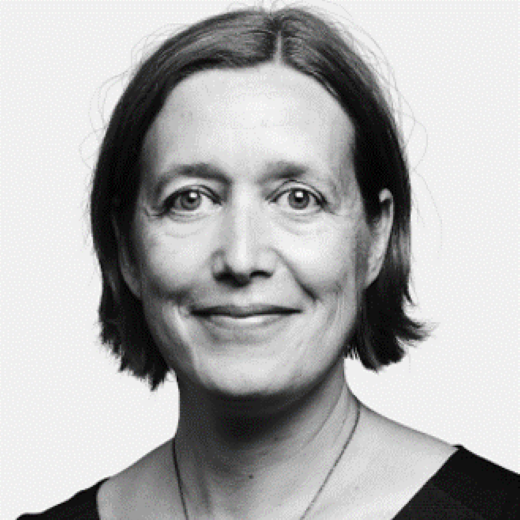
11:15 - 12:00
A 6G wish list based on IoT use cases
Fredrik Gustafsson, Professor at Linköping University, Sweden
Abstract
Narrow-band IoT (NB-IoT) and LTE CAT-M1 were introduced in 3GPP Release 13 in 2016. These modes were specifically aimed for indoor, low power, low cost data communication services. Today, they are used in many outdoor IoT devices globally. Practical use cases have identified issues with both startup time and energy consumption in rural areas, and the energy budget needed in practice is difficult to predict. Localisation services from GNSS still require a substantial energy budget, and network based localisation is rather unreliable. Another issue is the market strategy of Swedish operators that do not offer low cost SIM cards for IoT devices and poor connectivity in certain areas, which has forced many actors to invest in private networks like LoRaWAN. The presentation will describe a number of IoT applications, their challenges, opportunities and lessons learnt leading to a wish list of specifications for 6G, and how the 3GPP plans for ambient IoT and network-compute may contribute to better IoT solutions in the future.
Biography
Fredrik Gustafsson is professor in sensor informatics at Linköping University. He is a Distinguished Professor (rådsprofessor) awarded from the Swedish Research Council 2015-2024. IEEE Fellow (2011), and elected member of the Royal Academy of Engineering Sciences (IVA) 2007. He has supervised 25 PhD, 25 licentiate and more than 300 master thesis students. He is the author of five books and over 300 conference papers, 100 journal papers and some 25 patents, with h-index 72. He was the co-founder of NIRA Dynamics AB, Softube AB, Senion AB and the tech-for-good initiative project Ngulia.
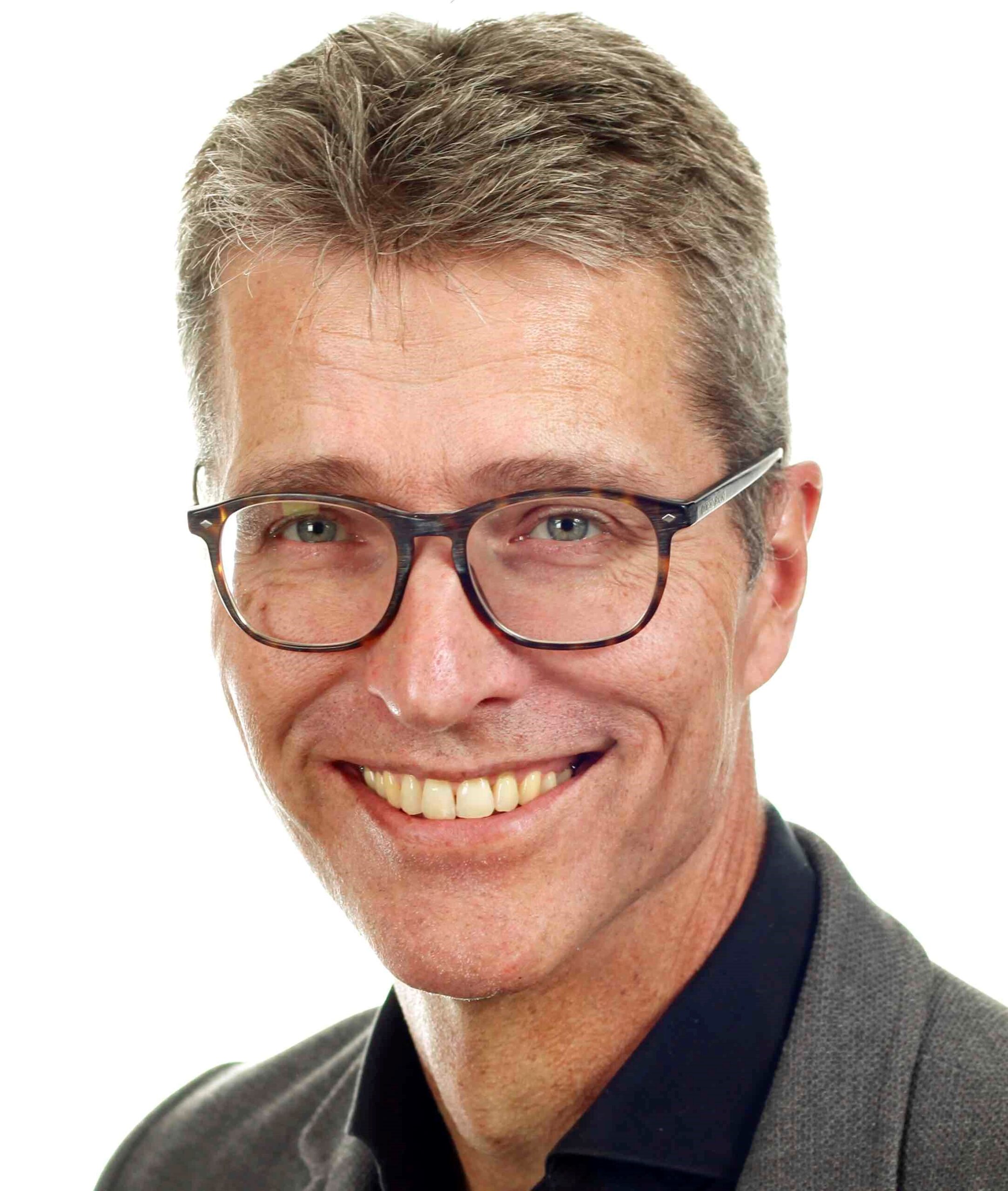
12:00 - 13:00
Lunch
13:00 - 13:45
Distributed Massive-MIMO for 6G: Beyond Communications Klaus Witrisal
Klaus Witrisal, Associate Professor at Graz University of Technology, Austria
Abstract
6G wireless networks will have to provide unprecedented data throughput, ultra-high reliability, unperceivable latency, and massive deployment, achieving magnitude-order enhancements of total energy efficiency. Distributed massive MIMO, where physically large antenna arrays are paired with coordinated multipoint operation, are a promising candidate technology for such networks. In this approach, the network infrastructure is distributed all around the users and moved to close proximity of them, which removes the bottleneck of centralized base stations and thus yields a radical enhancement of energy efficiency. This research talk will describe the implications that physically large and distributed arrays will have on a wireless network. The near-field effects will be illustrated, which result in a transformative shift of the radio channel properties. A range of new and enhanced functionalities will be enabled, extending from ultra-efficient and reliable communications, highly-accurate and robust localization, sensing, and wireless power transfer. The discussion will focus on the channel characteristics of such a system in a multipath environment and elaborate on resulting system properties and design challenges.
Biography
Klaus Witrisal received the Ph.D. degree (cum laude) from Delft University of Technology, Delft, The Netherlands, in 2002, and the Habilitation from Graz University of Technology in 2009. He is currently an Associate Professor at the Signal Processing and Speech Communication Laboratory (SPSC) of Graz University of Technology and head of the Christian Doppler Laboratory for Location-aware Electronic Systems, where he participates in a range of national and international research projects with industrial and academic partners. His research interests are in signal processing for wireless communications, propagation channel modeling, and positioning. Klaus Witrisal served as an associate editor of IEEE Communications Letters, co-chair of the TWG “Indoor” of the COST Action IC1004, co-chair of the EWG “Localisation and Tracking” of the COST Action CA15104, leading chair of the IEEE Workshop on Advances in Network Localization and Navigation (ANLN), and TPC (co)-chair of the Workshop on Positioning, Navigation and Communication (WPNC).
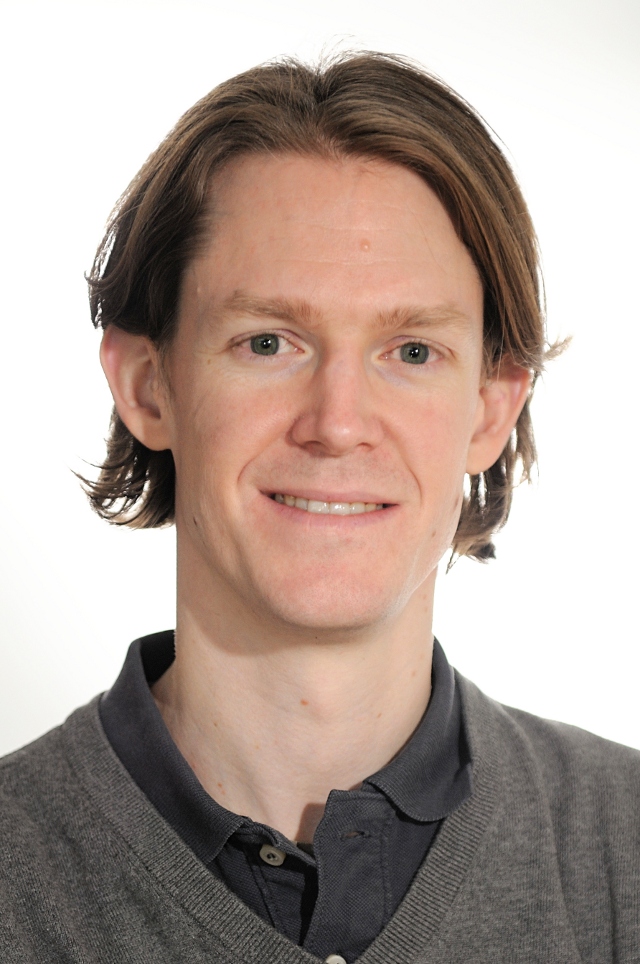
13:45 - 14:30
Radio Localization and Sensing: the path from 5G to 6G
Henk Wymeersch, Professor at Chalmers University of Technology, Sweden
Abstract
Increases in carrier frequencies and bandwidths, driven by high-rate communication applications have led to vastly improved capabilities for user positioning. With research underway towards 6G, opportunities for integrating positioning and sensing into the communication system have become even more apparent. The aim of this talk is to provide an overview of this evolution, focusing on 5G and 6G. The talk will comprise 3 main parts: first, the foundations of radio-based positioning are briefly introduced. Second, we go deeper into 5G positioning, covering both the standard approaches, as well as more forward-looking potential modifications. In the last part, we consider 6G from the perspective of positioning and sensing, highlighting some of the use cases, requirements, enablers, but also the corresponding challenges.
Biography
Henk Wymeersch obtained the Ph.D. degree in Electrical Engineering/Applied Sciences in 2005 from Ghent University, Belgium. He is currently a Professor of Communication Systems with the Department of Electrical Engineering at Chalmers University of Technology, Sweden. He is also a Distinguished Research Associate with Eindhoven University of Technology. Prior to joining Chalmers, he was a postdoctoral researcher from 2005 until 2009 with the Laboratory for Information and Decision Systems at the Massachusetts Institute of Technology. Prof. Wymeersch served as Associate Editor for IEEE Communication Letters (2009-2013), IEEE Transactions on Wireless Communications (since 2013), and IEEE Transactions on Communications (2016-2018) and is currently Senior Member of the IEEE Signal Processing Magazine Editorial Board. During 2019-2021, he was an IEEE Distinguished Lecturer with the Vehicular Technology Society. His current research interests include the convergence of communication and sensing, in a 5G and Beyond 5G context.

14:30 - 15:00
Coffee
15:00 - 15:45
6G – can we escape gravity?
Muriel Medard, Professor at the Massachusetts Institute of Technology, USA
Abstract
While 5G has provided some notable successes in introducing new technologies, such as millimeter wave and massive multi-input multi-output (MIMO) communications, many of the original desiderata such as URLLC have been pushed back to 6G. The causes of these unrealized ambitions are varied, but much can be attributed to the fact that the architecture of 5G remains patterned after previous generations, an overlay of many quasi-sedimentary layers of successive legacies. Paradoxically, these multiple layers have not led to a finely granular design that enables complementary innovation in individual subcomponents. We propose a modular approach that will break the current logjam. While ORAN has made significant strides in modularizing management systems, lower layers remain constrained, from interleaving, to limitations on codes such as CA-Polar and LDPCs, to hybrid ARQ and ARQ, 5G has often resorted to increasing bandwidth to mask the inefficiencies of these legacy issues. In a manner akin to having a API call, we propose to organize systems according to units that fulfill a purpose, in a way that enables each unit to be modular, to permit incorporation of new technologies without undue obstacles. We illustrate the possible gains through technologies such as a Guessing Random Additive Noise Decoding (GRAND) to outperform current 5G coding systems, and through network coding to replace HARQ/ARQ.
Biography
Muriel Médard is the NEC Professor of Software Science and Engineering in the School of Engineering at MIT and a Professor in the Electrical Engineering and Computer Science (EECS) Department at MIT. She leads the Network Coding and Reliable Communications Group in the Research Laboratory for Electronics at MIT and Chief Scientist for Steinwurf, which she has co-founded. She obtained three Bachelors degrees, as well as her M.S. and Sc.D, all from MIT. Muriel is a Member of the US National Academy of Engineering (elected 2020), a Member of the German National Academy of Sciences Leopoldina (elected 2022), a Fellow of the US National Academy of Inventors (elected 2018), American Academy of Arts and Sciences (elected 2021), and a Fellow of the Institute of Electrical and Electronics Engineers (elected 2008). She holds Honorary Doctorates from the Technical University of Munich (2020) and from The University of Aalborg (2022).
Muriel was awarded the 2022 IEEE Kobayashi Computers and Communications Award. She received the 2017 IEEE Communications Society Edwin Howard Armstrong Achievement Award and the 2016 IEEE Vehicular Technology James Evans Avant Garde Award. Muriel was co-winner of the MIT 2004 Harold E. Egerton Faculty Achievement Award and was named a Gilbreth Lecturer by the US National Academy of Engineering in 2007.
She received the 2019 Best Paper award for IEEE Transactions on Network Science and Engineering, the 2018 ACM SIGCOMM Test of Time Paper Award, the 2009 IEEE Communication Society and Information Theory Society Joint Paper Award, the 2009 William R. Bennett Prize in the Field of Communications Networking, the 2002 IEEE Leon K. Kirchmayer Prize Paper Award, as well as nine conference paper awards. Most of her prize papers are co-authored with students from her group.
Muriel currently serves as the Editor-in-Chief of the IEEE Transactions on Information Theory and served previously as Editor in Chief of the IEEE Journal on Selected Areas in Communications. Muriel was elected president of the IEEE Information Theory Society in 2012, and serves on its board of governors, having previously served for eleven years.
Muriel has supervised over 40 master students, over 20 doctoral students and over 25 postdoctoral fellows.
Muriel received the inaugural MIT Postdoctoral Association Mentoring Award in 2022, the inaugural MIT EECS Graduate Student Association Mentor Award, voted by the students in 2013. She set up the Women in the Information Theory Society (WithITS) and Information Theory Society Mentoring Program, for which she was recognized with the 2017 Aaron Wyner Distinguished Service Award.
Muriel has over sixty US and international patents awarded, the vast majority of which have been licensed or acquired. For technology transfer, she has co-founded CodeOn, for intellectual property licensing. and Steinwurf, for reliable and low-latency networking. She serves on the Nokia Bell Labs Technical Advisory Board.
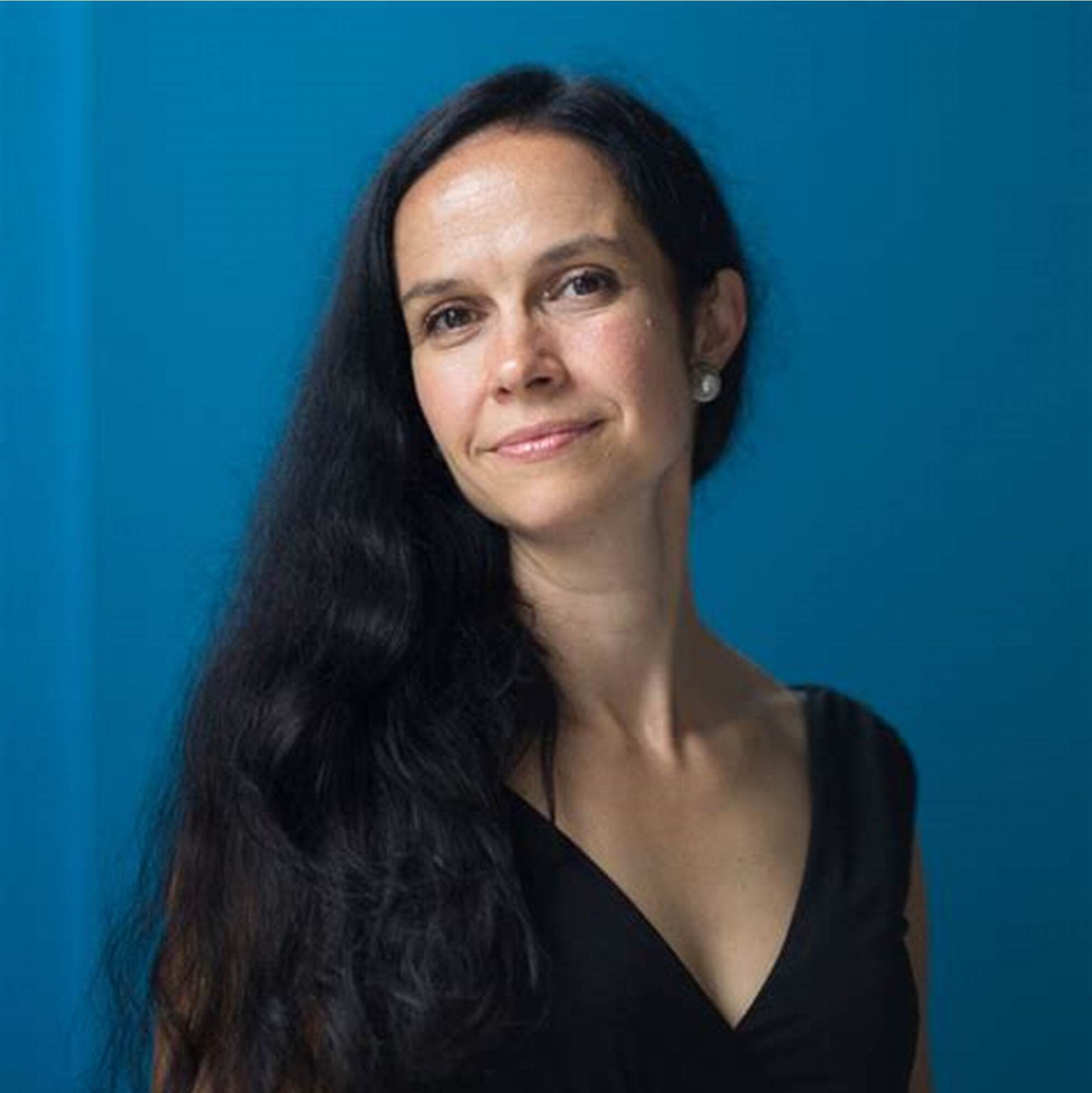
15:45 - 17:00
Poster session with snacks
Day 2 – November 9, 2023
09:15 - 10:00
Designing 6G radios – challenge for RF?
Aarno Pärssinen, Professor at the University of Oulu, Finland
Abstract
Currently anticipated 6G targets are looking towards 100Gbps or even 1Tbps data rates over radio connection to facilitate new use cases and match the demand of capacity in various scenarios. We will face boundaries of semiconductor and other technologies especially once targeting towards communications and sensing above 100GHz. This presentation discusses some key challenges and opportunities to address these issues from systems to circuits and testing.
Biography
Aarno Pärssinen received the D.Sc. degree from the Helsinki University of Technology, Finland, in 2000. From 2000 to 2011 he was with Nokia Research Center, Helsinki, Finland where he served as a member of Nokia CEO Technology Council from 2009 to 2011. From 2011 to 2013, he was at Renesas Mobile Corporation and then joined Broadcom as part of business acquisition until September 2014. Since September 2014 he has been with University of Oulu, Centre for Wireless Communications, Finland where he is currently a Professor. He leads Devices and Circuits research area in 6G flagship program financed by Academy of Finland. His research interests include wireless systems and transceiver architectures for wireless communications. Aarno Pärssinen has authored and co-authored one book, two book chapters, more than 200 international journal and conference papers and holds several patents. He served as a member of the technical program committee of Int. Solid-State Circuits Conference in 2007-2017, chairing the wireless subcommittee in 2014-2017.
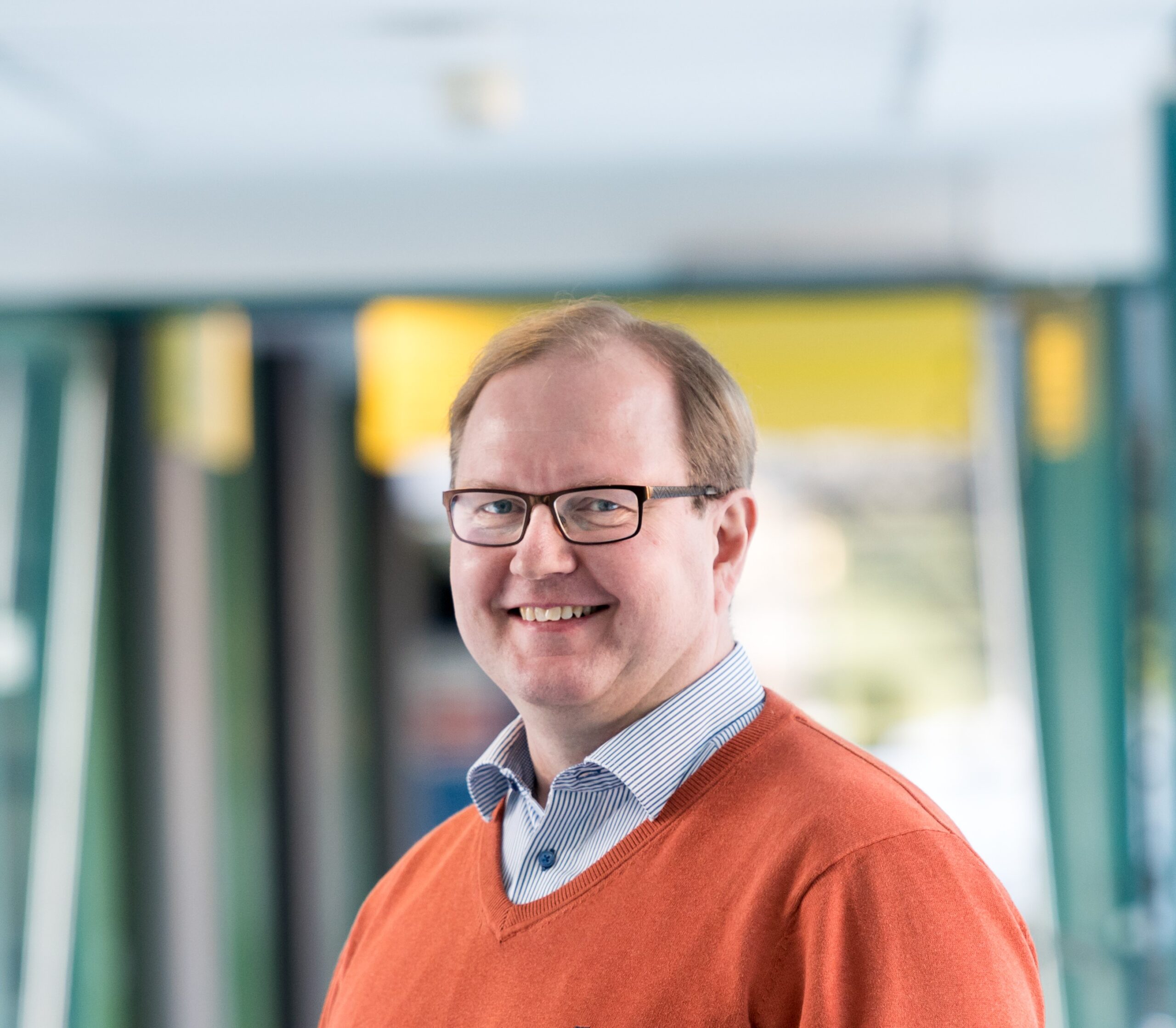
10:00 - 10:30
Coffee
10:30 - 11:15
How to co-design wireless networked control systems
Karl Henrik Johansson at Professor at KTH Royal Institute of Technology, Sweden
Abstract
The efficiency of control systems that operate over shared communication networks closely relates to the network’s ability to deliver services and allocate resources. Emerging cellular network technologies offer customized services for diverse network needs. Given the strict real-time control requirements and safety specifications, there is a demand for adaptable, control-aware network services. This insight points towards a combined design of both physical and network layers with the control laws, to guarantee that the required quality-of-service matches the intended quality-of-control. However, achieving an optimal combined design is tricky due to the interdependencies between layers, where the design necessarily hinges also on the amount of shared information in the system. In this talk, we will discuss how to formulate and solve such co-design problems. We will illustrate the results through examples from vehicular control and industrial automation. The presentation is based on joint work with Vahid Mamduhi, Dipankar Maity and others.
Biography
Karl H. Johansson is Professor with the School of Electrical Engineering and Computer Science at KTH Royal Institute of Technology in Sweden and Director of Digital Futures. He received MSc degree in Electrical Engineering and PhD in Automatic Control from Lund University. He has held visiting positions at UC Berkeley, Caltech, NTU, HKUST Institute of Advanced Studies, and NTNU. His research interests are in networked control systems and cyber-physical systems with applications in transportation, energy, and automation networks. He is President of the European Control Association and member of the IFAC Council, and has served on the IEEE Control Systems Society Board of Governors and the Swedish Scientific Council for Natural Sciences and Engineering Sciences. He has received several best paper awards and other distinctions from IEEE, IFAC, and ACM. He has been awarded Swedish Research Council Distinguished Professor, Wallenberg Scholar with the Knut and Alice Wallenberg Foundation, Future Research Leader from the Swedish Foundation for Strategic Research, the triennial IFAC Young Author Prize, and IEEE Control Systems Society Distinguished Lecturer. He is Fellow of the IEEE and the Royal Swedish Academy of Engineering Sciences.

11:15 - 12:00
Active Learning for Communications and Sensing
Wei Yu, Professor at the University of Toronto, Canada
Abstract
Machine learning will play an important role in the optimization of future-generation physical-layer wireless communication systems for the following two reasons. First, traditional wireless communication design always relies on the channel model, but models are only an approximation to reality. In wireless environments where the modelling task is complex and the channels are costly to estimate, a learning-based approach can significantly outperform the traditional model-based approaches. Second, modern wireless communication design often involves optimization problems that are high-dimensional, nonconvex, and difficult to solve efficiently. By exploring the availability of training data, a neural network may be able to learn the solution of an optimization problem directly. This talk will focus on a data-driven approach for integrated sensing and communications system design. We show that a recurrent neural networks based on a long short-term memory architecture can be trained to learn solutions to sequential active sensing problems effectively. The proposed learning-based approach can be used for designing active beamforming strategy for mmWave initial beam alignment and for configuring the reflective coefficients of reconfigurable intelligent surfaces in a sequential manner for both localization and object tracking.
Biography
Wei Yu is a Professor in the Electrical and Computer Engineering Department at the University of Toronto, where he holds a Canada Research Chair in Information Theory and Wireless Communications. He received a Ph.D. degree in Electrical Engineering from Stanford University. He is a Fellow of the IEEE and a Fellow of the Canadian Academy of Engineering. He received the Steacie Memorial Fellowship in 2015, the IEEE Marconi Prize Paper Award in Wireless Communications in 2019, the IEEE Communications Society Award for Advances in Communication in 2019, the IEEE Signal Processing Society Best Paper Award in 2008, 2017 and 2021, and the IEEE Communications Society Best Tutorial Paper Award in 2015. Prof. Wei Yu served as the President of the IEEE Information Theory Society in 2021.

12:00 - 13:00
Lunch
13:00 - 13:45
The revolution of New Space towards next G communication networks
Ana Pérez-Neira, Professor at Universitat Politècnica de Catalunya, Spain
Abstract
We imagine the future communication networks as 3-Dimensional, fully integrating the terrestrial and the satellite infrastructure, so that communication services can be everywhere and anytime available. We are most familiar with terrestrial radio communications, but what about satellite communications? They are currently experiencing the New Space revolution. This talk will explain what does this revolution really mean. It’s goal is a democratization of space that suggests that access to launch, manufacturing of satellites, and/or leveraging Low-Earth Orbit (LEO) connectivity to deliver data transmission capability to remote locations is widely available because these services are commoditized and affordable, enabling them to be equitably distributed to diverse user groups, rich and poor alike. The reality, however, is that the delivery of space-based value-added services to remote locations around the world will require groundbreaking innovations. This talk will introduce a number of key technologies powering the New Space age and the integration with the terrestrial segment: i) advances in signal processing and computing on board satellites to enable edge in space, ii) the emergence of commoditised, high bandwidth optical Inter Satellite Links (ISL) that enable joint communication and computing, and iii) advances in antenna technology. The talk will pay special attention to this latter detailing the innovative possibilities that mega-constellations and swarm satellite offer for distributed spatial processing.
Biography
Ana Pérez-Neira is full professor at Universitat Politècnica de Catalunya in the Signal Theory and Communication department since 2006 and was Vice rector for Research (2010-14). Currently, she is the Director of Centre Tecnològic de Telecomunicacions de Catalunya, Spain. Her research is in signal processing for communications, focused on satellite communications. She is the coordinator of the Networks of Excellence on satellite communications, financed by the European Space Agency: SatnexIV-V. She is IEEE Fellow, EURASIP Fellow, and member of the Real Academy of Science and Arts of Barcelona (RACAB). She is recipient for the 2018 EURASIP Society Award and she has been the general chair of IEEE ICASSP’20 (the first big IEEE virtual conference held by IEEE with more than 15.000 attendees). In 2020, she has been awarded the ICREA Academia distinction by the Catalan government. Currently, she is member of the BoG of the IEEE SPS and Vice-President for conferences (2021-23).
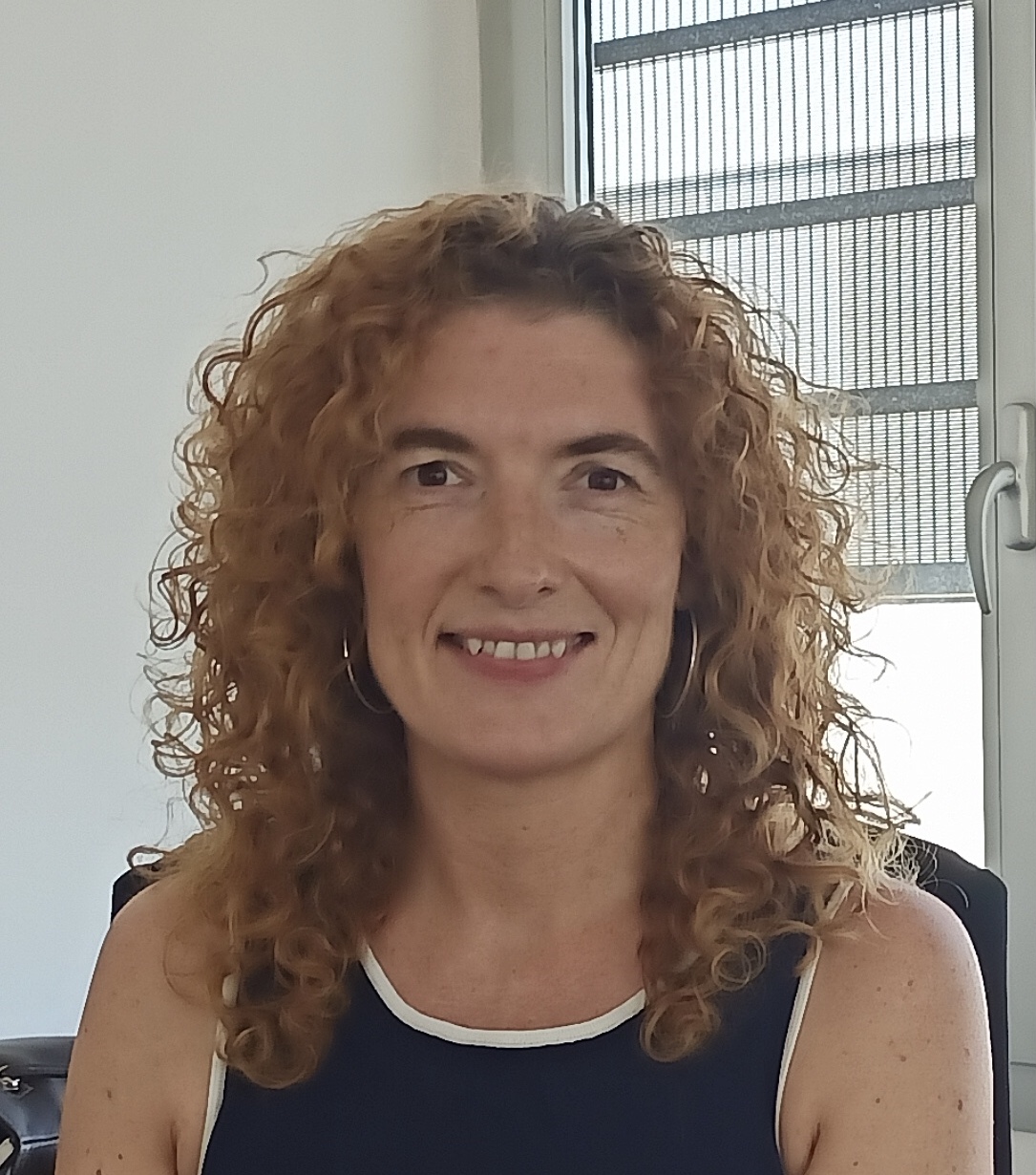
13:45 - 14:30
Differentiable Ray-Tracing for Digital Twin Networks
Jakob Hoydis, Principal Research Scientist at NVIDIA, USA
Abstract
The creation of digital twin networks requires precise scene modeling and ray tracing for radio propagation prediction. Differentiable ray tracing is a new paradigm which allows for gradient based optimization of many scene parameters and enables data-driven calibration of ray tracing models to measurements. I will present some recent results of this novel field of research and highlight challenges as well as interesting directions for future research.
Biography
Jakob Hoydis is a Principal Research Scientist at NVIDIA working on the intersection of machine learning and wireless communications. Prior to this, he was Head of a research department at Nokia Bell Labs, France, and co-founder of the social network SPRAED. He obtained the diploma degree in electrical engineering from RWTH Aachen University, Germany, and the Ph.D. degree from Supéléc, France. From 2019-2021, he was chair of the IEEE COMSOC Emerging Technology Initiative on Machine Learning as well as Editor of the IEEE Transactions on Wireless Communications. Since 2019, he is Area Editor of the IEEE JSAC Series on Machine Learning in Communications and Networks.
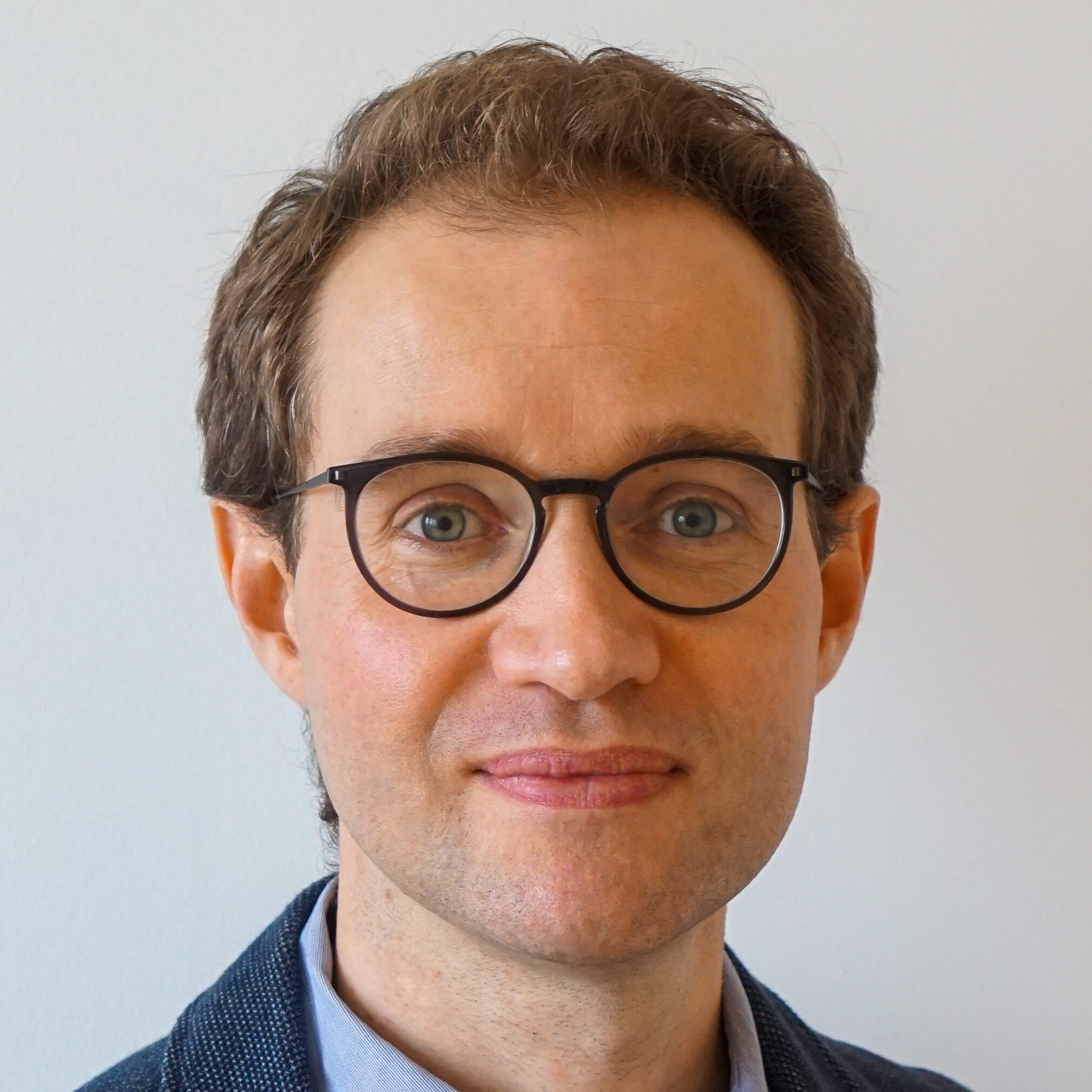
14:30 - 15:00
Coffee
15:00 - 15:45
New Methods for Multi-Antenna Jammer Mitigation
Christoph Studer, Associate Professor at ETH Zurich, Switzerland
Abstract
Jamming attacks pose a perennial threat to wireless communication infrastructure, necessitating the development of resilient systems to counter such attacks. Multi-antenna systems offer a potential solution for mitigating jammers through spatial filtering, but implementing these methods in practice is challenging. The first challenge relates to RF hardware: Strong jamming signals can overload the analog-to-digital converters (ADCs) and drown the useful signals in quantization noise. Consequently, the resulting nonlinearities diminish the effectiveness of digital spatial filtering. As a remedy, we propose hybrid architectures that mitigate the jamming signal before the ADCs. The second challenge relates to smart jammers: Spatial filtering necessitates knowledge of the jammer channel. In the case of simple barrage jammers, this information can be obtained using a training interval during which the jammer channel can be estimated. However, a smart jammer (e.g., a protocol-aware or a reactive jammer) might cease jamming during the training interval to evade estimation (and hence mitigation). A multi-antenna jammer might even modulate the subspace on which it is jamming by using time-varying beamforming. To counteract such smart and dynamic jammers, we propose a novel paradigm called JMD (Joint jammer Mitigation and data Detection) as well as JMD-type jammer mitigation algorithms.
Biography
Christoph Studer is an Associate Professor at ETH Zurich. He received his M.S. and Ph.D. degrees at the Department of Information Technology and Electrical Engineering at ETH Zurich in 2006 and 2009, respectively. In 2005, he was a visiting researcher with the Smart Antennas Research Group at Stanford University. From 2009 to 2014, he was a postdoctoral researcher with the Communication Technology Laboratory at ETH Zurich and the Digital Signal Processing Group at Rice University in Houston, Texas. From 2014 to 2019, he was an Assistant Professor in the School of Electrical and Computer Engineering at Cornell University in Ithaca, New York, and from 2019 to 2020, he was an Associate Professor at Cornell University and at Cornell Tech in New York City. Prof. Studer’s research interests are at the intersection of communication theory, machine learning, and digital VLSI design. Prof. Studer received ETH Medals for his M.S. and Ph.D. theses, a two-year Swiss National Science Foundation fellowship for Advanced Researchers, and a US National Science Foundation CAREER Award. He has won several best-paper and live demonstration awards at international conferences, and he has received the Swisscom/ICTnet Innovations Award twice.
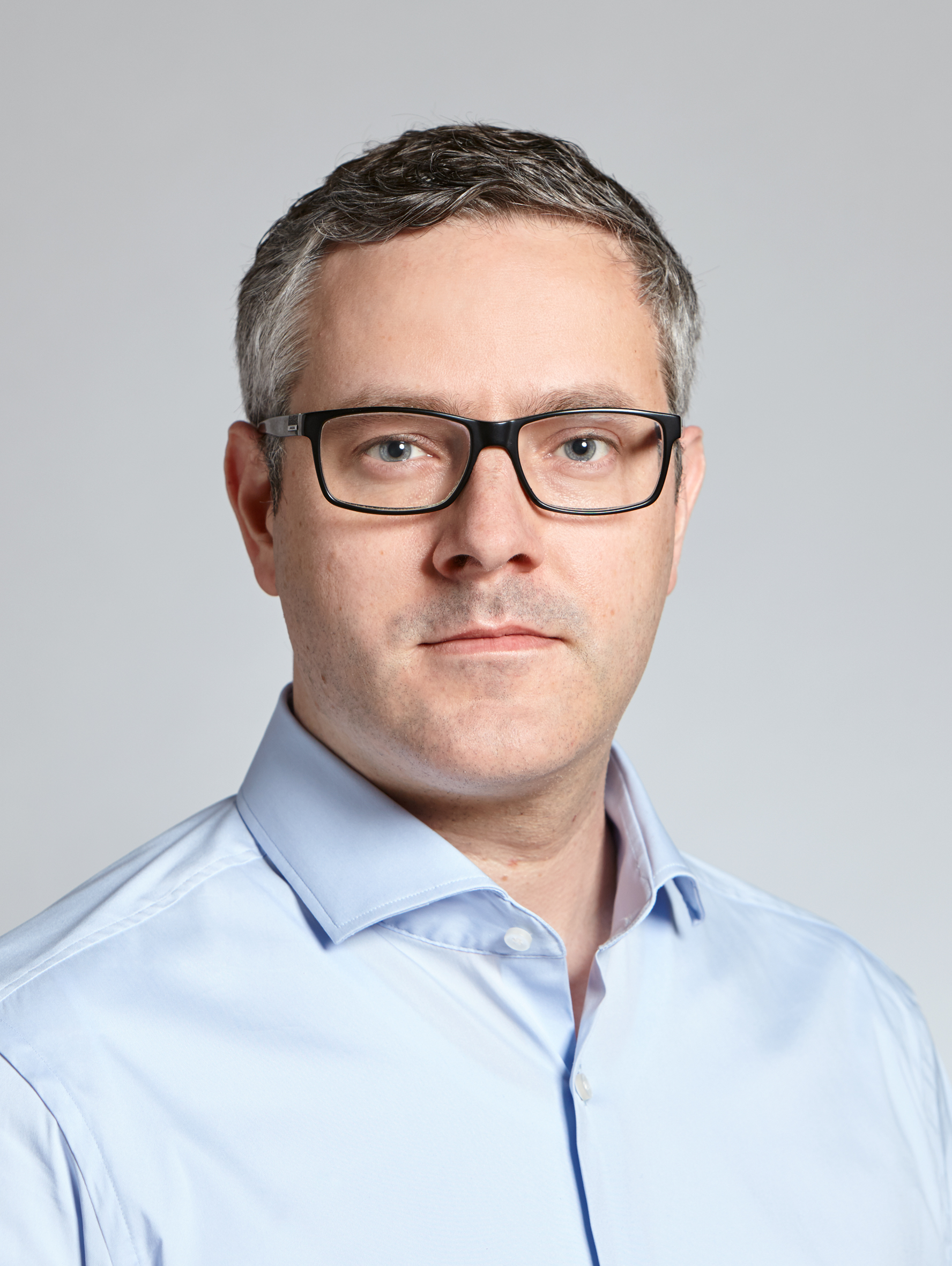
15:45 - 16:30
Access Protocols for Wireless Systems with Reconfigurable Intelligent Surfaces
Petar Popovski, Professor at Aalborg University, Denmark
Abstract
The widespread adoption of Reconfigurable Intelligent Surfaces (RISs) in future practical wireless systems is critically dependent on the availability of efficient access protocols. The design of access protocols is based on the mode of operation of the control channel, used to exchange information for real-time control of the RIS. This talk will introduce the two principal options for a RIS control channel: in-band and out-of-band. Out-of-band control channel exerts control over the propagation environment, but is not affected by this control. In-band control channel uses the same communication resources as the data communication, such that it is affected by the control exerted on the propagation environment. These two options lead to different types of access protocols, which will be discussed in the talk. Next, a grant-free random access (RA) protocol will be presented, intended for a massive number of accessing users. The proposed protocol relies on a channel oracle, which enables the users to infer the best RIS configurations that provide opportunistic access. This inference is based on a model created during a training phase with a greatly reduced set of RIS configurations, inspired by the Shannon-Nyquist sampling theorem.
Biography
Petar Popovski is a Professor at Aalborg University, where he heads the section on Connectivity and a Visiting Excellence Chair at the University of Bremen. He received his Dipl.-Ing and M. Sc. degrees in communication engineering from the University of Sts. Cyril and Methodius in Skopje and the Ph.D. degree from Aalborg University in 2005. He is a Fellow of the IEEE. He received an ERC Consolidator Grant (2015), the Danish Elite Researcher award (2016), IEEE Fred W. Ellersick prize (2016), IEEE Stephen O. Rice prize (2018), Technical Achievement Award from the IEEE Technical Committee on Smart Grid Communications (2019), the Danish Telecommunication Prize (2020) and Villum Investigator Grant (2021). He is currently the Editor-in-Chief of IEEEE JOURNAL ON SELECTED AREAS IN COMMUNICATIONS. Prof. Popovski was the General Chair for IEEE SmartGridComm 2018 and IEEE Communication Theory Workshop 2019. His research interests are in communication theory and wireless connectivity. He authored the book “Wireless Connectivity: An Intuitive and Fundamental Guide”, published by Wiley in 2020.

18:30 -
Grand Hotel, Bantorget 1, 222 29 Lund
Symposium Dinner
Day 3 – November 10, 2023
09:15 - 10:00
Resource allocation in D-MIMO, which antennas to connect to? Doppler based positioning in D-MIMO
Visiting Scholars
10:00 - 10:30
Coffee
10:30 - 11:15
Convergence of communication and computing at the Network Edge
Toktam Mahmoodi, Professor at King’s College London, UK
Abstract
A key element in future communication systems is the integration of communication with sensing, computing and cognition, which drives two major paradigm shifts. The first is the convergence of communication and computing technologies in interconnecting intelligence. This, together with the decoupling of services from the underlying hardware enables rapid and flexible in-network service deployment and advanced in-network processing. The first shift also results in a second that is moving away from the assumption of a universal computing architecture in the communication systems, acknowledging the critical importance of the computing architecture in the effective and efficient implementation of intelligence. This talk will focus on the convergence of communication and computing technologies, and how network edge embraces this convergence, as well as discussing some of our recent works in this area.
Biography
Toktam Mahmoodi is a professor of communication Engineering and Director of the Centre for Telecommunications Research (CTR) in Department of Engineering at King’s College London. Her research focuses on the areas of mobile and cloud networking, and includes autonomous network management, edge-intelligence, and ultra-low latency networking. She also works on applications of mobile communications in the healthcare, smart cities, emergency services, industrial networks and intelligent transportation.
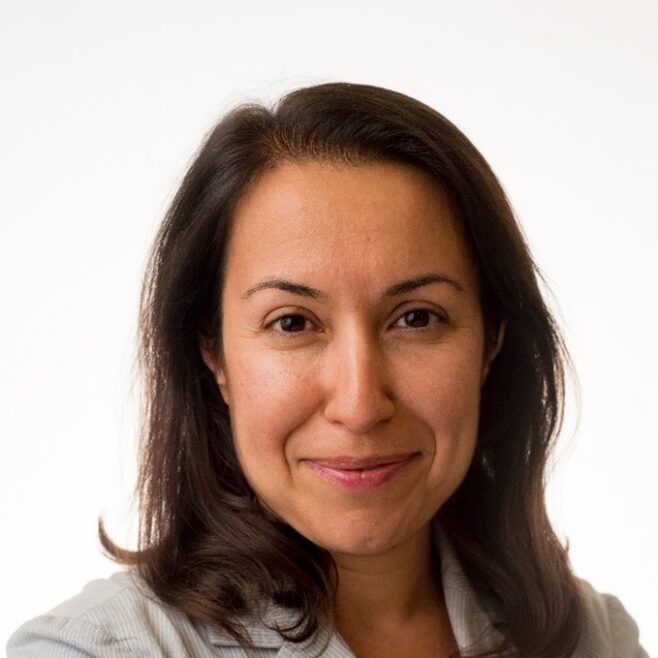
11:15 - 12:00
Modelling and Managing the Future Cloud-Edge Continuum
Paul Townend, Associate Professor at Umeå University, Sweden
Abstract
Cloud-Edge architectures will play a central role in 6G technologies – but what will they look like, and how can they be monitored and managed? This talk will look at the concept of a “Continuum” of devices, and will discuss current attempts to model, monitor and manage such an infrastructure with a focus on software aspects and energy consumption. As part of this discussion, the 6M euro COGNIT project will be introduced – a new project funded by the European Union that is attempting to build an open-source European reference implementation for Continuum systems.
Biography
Paul Townend (https://www.umu.se/en/staff/paul-townend/) is an Associate Professor at Umeå University (UmU) since 2020. He is a Research Leader within the Umeå Autonomous Distributed Systems Lab and has led/co-led over 50M SEK in successfully completed research projects. Paul is currently Scientific Coordinator of the SovereignEdge project (Horizon Europe, 2023-2025) that seeks to create a European Reference Architecture for task placement in serverless systems, Scientific Coordinator of the WASP WARA-Ops research arena (WASP, 2023-2025), and Co-I of the “Etablering av ett de facto Excellenscenter inom Autonoma Distribuerade System” project (Kempe Foundation, 2022-2026).
Paul is the Leader of the WASP Autonomous Clouds and Networks area cluster, coordinator and examiner of the WASP Cloud Computing and Software Engineering foundational course, and member of the WASP Graduate School Management (GSM) group.
Previously, Paul was CTO (2017-2020) of Edgetic Ltd – a UK university start-up company focussing on developing modelling and scheduling software for improving energy-efficiency in Cloud-Edge systems. Prior to this, he was Research Fellow and University Academic Fellow at the University of Leeds, UK (2004-2017) where he was Team Leader of the Distributed Systems and Service (DSS) group. He has served as General Chair for 14 IEEE international conferences.

12:00 - 13:00
Lunch
13:00 - 13:45
Massive Near-Field Spatial Multiplexing
Emil Björnson, Professor at KTH Royal Institute of Technology, Sweden
Abstract
The attempts to use mmWave bands in cellular networks have largely failed. The latest example is South Korea which closed down all its networks. As we are running out of spectrum suitable for wide-area connectivity, we must search for alternative ways to cater to the exponential traffic growth. In this talk, we take a look at whether multiple-input multiple-output (MIMO) technology can lead the way. The concepts of radiative near-field propagation, spherical wavefronts, finite-depth beamforming, and spatial degrees of freedom will be explained and connected to the antenna array dimensions. We will conclude on whether massive spatial multiplexing is the next untapped resource that can boost the capacity of 6G networks.
Biography
Emil Björnson is a Professor of Wireless Communication at the KTH Royal Institute of Technology, Stockholm, Sweden. He is an IEEE Fellow, Digital Futures Fellow, and Wallenberg Academy Fellow. He has a podcast and YouTube channel called Wireless Future. His research focuses on multi-antenna communications and radio resource management, using methods from communication theory, signal processing, and machine learning. He has authored three textbooks and has published a large amount of simulation code.
He has received the 2018 and 2022 IEEE Marconi Prize Paper Awards in Wireless Communications, the 2019 EURASIP Early Career Award, the 2019 IEEE Communications Society Fred W. Ellersick Prize, the 2019 IEEE Signal Processing Magazine Best Column Award, the 2020 Pierre-Simon Laplace Early Career Technical Achievement Award, the 2020 CTTC Early Achievement Award, and the 2021 IEEE ComSoc RCC Early Achievement Award. He also received six Best Paper Awards at conferences.

13:45 - 14:30
Flexible waveforms for 6G
Ana Garcia Armada, Professor at Universidad Carlos III de Madrid, Spain
Abstract
The evolution of mobile communications towards 6G will enable new applications and services. These require that the radio interface can meet new key performance indicators (KPIs) operating in all kinds of environments, including some challenging ones that were not fully covered with 5G. The waveforms and the way the radio resources are organized have an important impact on the achievability of the KPIs and the ubiquitous provision of mobile services. This talk examines the properties, advantages, and disadvantages of some recently proposed waveforms. Given that there is not a one-size-fits-all solution, the key is flexibility, that is enabled by the multi-carrier nature of most of the proposals making use of the Fast Fourier Transform. Additionally, channel state information (CSI) is needed for coherent demodulation, and ways to multiplex the pilots and data in an efficient way are explored, together with the option of not requiring CSI via non-coherent demodulation. The talk concludes with some remarks about the new services that the flexible combination of waveforms and radio resource management for joint communications and sensing can enable.
Biography
Ana Garcia Armada is a Professor at Universidad Carlos III de Madrid (UC3M), Spain. She has been a visiting scholar at Stanford University, Bell Labs, and University of Southampton. She has published more than 250 papers in conferences and journals and she holds five patents. She serves on the editorial boards of IEEE Transactions on Communications, IEEE Open Journal of the Communications Society and ITU Journal on Future and Evolving Technologies. She has been a member of the organizing committee of several conferences, including IEEE Globecom 2021 as the General Chair. She has received several awards from UC3M, the third place Bell Labs Prize 2014, the outstanding service award from the IEEE ComSoc Signal Processing and Communications Electronics technical committee, the outstanding service award from the IEEE ComSoc Women in Communications Engineering standing committee and the IEEE ComSoc/KICS Exemplary Global Service Award. Her research mainly focuses on signal processing applied to wireless communications.
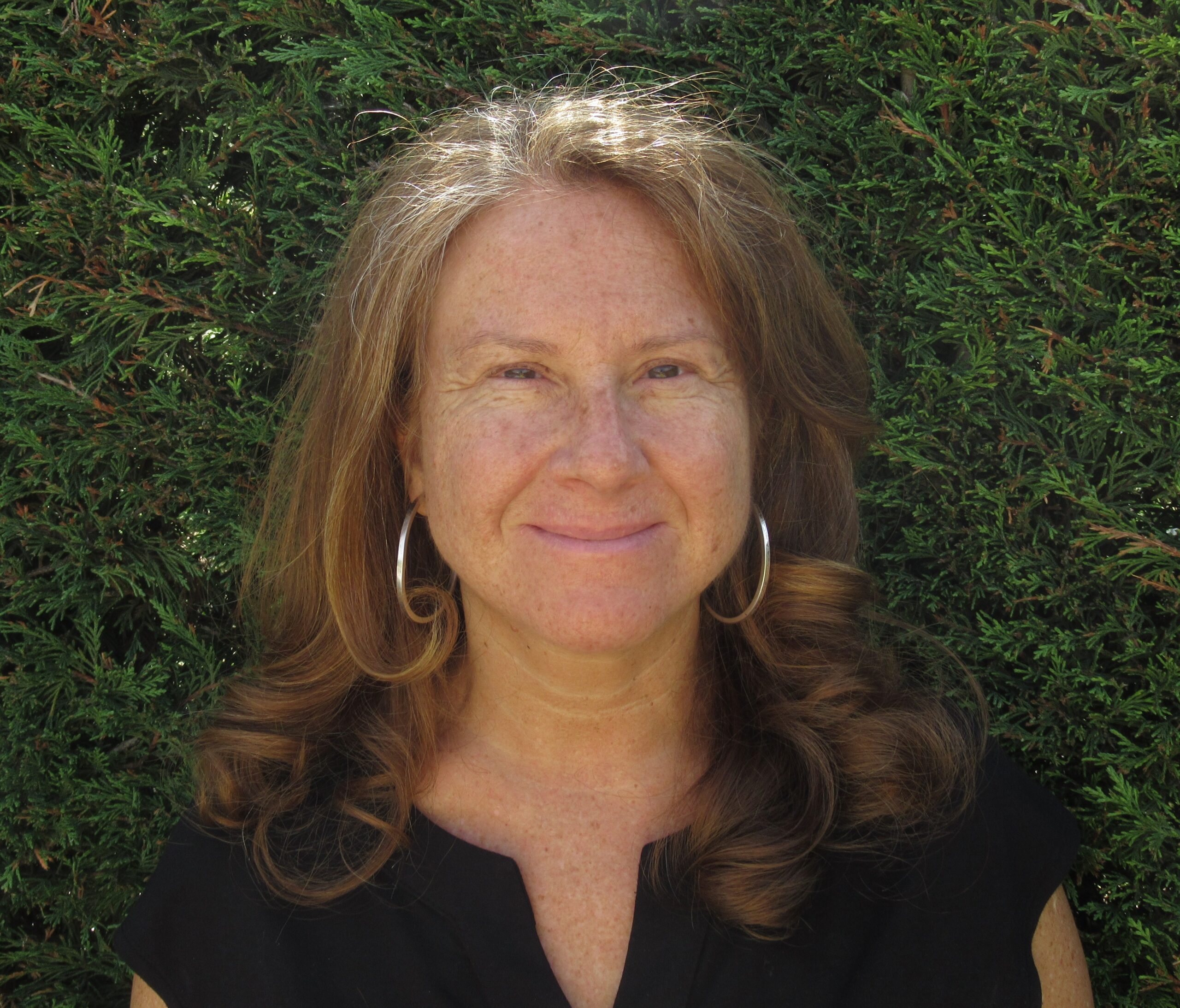
14:30 - 15:00
Coffee
15:45 - 16:30
6G and Large Intelligent Surfaces from a practical perspective
Ove Edfors & Fredrik Tufvesson, Lund University, Sweden
Abstract
Large intelligent surfaces, distributed MIMO or cell free massive MIMO, are all relying on distributed active coherent antennas. It is one of the promising way forward for future generation communication and sensing, especially at the lower frequencies. There are, however, still open questions when it comes to realistic properties of the radio channel and how we actually can implement such a distributed coherent system. In the talk we will discuss some of the practical implementation details and point out directions for how such a system can be realized.
Biography
Ove Edfors is currently a Professor of radio systems with the Department of Electrical and Information Technology, Lund University, Lund, Sweden. His current research interests include statistical signal processing and low-complexity algorithms with applications in wireless communications. In the context of massive MIMO, his main research interests include how realistic propagation characteristics influence system performance and baseband processin
Fredrik Tufvesson received his Ph.D. in 2000 from Lund University in Sweden. After two years at a startup company, he joined the department of Electri[1]cal and Information Technology at Lund University, where he is now professor of radio systems. His main research interest is the interplay between the radio channel and the rest of the communication system with various applications in 5G/B5G systems such as massive MIMO, mm wave communication, vehicular communication and radio based positioning

